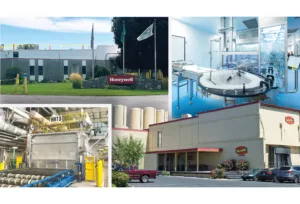
Home » LaBreck Stainless Works LLC: Tapping stainless steel tanks
LaBreck Stainless Works LLC: Tapping stainless steel tanks
-

March 26, 2015
Brandon LaBreck, owner of LaBreck Stainless Works LLC, says his biggest concern for the company is keeping up with demand as he looks to expand.
The three-year-old Hayden company’s mainstay is manufacturing and installing sanitary stainless steel tanks, and LaBreck Stainless Works has forged a solid niche in serving craft beer brewers.
“The stainless steel tank industry is a funny animal,” LaBreck says. “There’s a high demand, but not many people doing it.”
Stainless steel is the primary metal that’s deemed “food grade,” he says. Stainless steel is a family of steel alloys resistant to rust.
LaBreck says it takes a considerable amount of training and experience to become proficient at stainless steel fabrication. It’s more difficult to weld stainless steel than other metals because it can warp and distort under high heat.
“It isn’t a business that you can just throw people at,” LaBreck says. “It takes a specialized skill set.”
The company has eight employees, some of whom work part time.
“I have some local firemen working here,” LaBreck says, adding that many North Idaho firefighters have side jobs.
He describes the work as 25 percent fabrication, 25 percent welding, and 50 percent grinding.
Even the grinding is highly specialized, LaBreck says.
“We currently have 200 different abrasives,” he says.
LaBreck Stainless Works occupies 5,000 square feet of industrial space at 11365 N. Government Way, about 6 1/2 miles north of Interstate 90 at Coeur d’Alene.
The business has been located there for about a year, having already expanded once, and LaBreck says he plans to expand the company into larger space in another year.
LaBreck’s interest in metal fabrication sparked when he was a janitor at a welding shop in northwestern Oregon.
After learning to weld there, he put in 15 years at a stainless steel fabrication shop in Canby, Ore., about 25 miles south of Portland, working up to senior fabricator and lead field service technician in the pharmaceuticals department.
LaBreck did his first brewery work in 1998, and he estimates he had performed modifications and onsite repairs at 100 different breweries before starting up LaBreck Stainless Works.
“I saw how things break and how they can be better,” he says.
He and his wife, Angelica, and their son moved to North Idaho a few years ago to start up the new business, and they now have a second boy.
“I came here for a change,” he says. “I like the climate—both in people and the weather.”
When LaBreck first set up shop in Hayden, he visited local craft brewers to introduce himself and the company.
Now, most business comes through word of mouth, he says.
LaBreck’s most recent brewhouse installation was last week at Mad Bomber Brewing Co., in Hayden, where a new seven-barrel system with a 15-barrel fermenter replaces the brewpub’s original one-barrel system. A barrel is 31 gallons.
Tom Applegate, Mad Bomber co-owner and head brewer, says at times the brewpub has run out of beer with its small-batch setup. The new brewhouse setup not only will increase Mad Bomber’s output, but also will improve brewing consistency, Applegate says.
Other recent LaBreck Stainless Works customers include Drumheller Brewing Inc., of Spokane; MickDuff’s Brewing Co., of Sandpoint; and Kootenai River Brewing Co. & Restaurant, of Bonners Ferry.
Each brewery is different, but LaBreck says a typical stainless steel setup for a seven-barrel system would cost around $175,000, and a 15-barrel system would cost around $250,000.
A brewhouse system has a minimum of five vessels, LaBreck says.
One tank, called the hot liquor tank, holds heated water at the desired temperature. The next tank is called a mash tun, in which grain steeps in hot water, he says. The kettle is where liquid extracted from the mash is boiled and hops are added. Yeast converts sugar into alcohol and carbon dioxide gas in the fermentation tank, and yeast is cleared away in the bright beer tank.
A brewhouse system could include additional specialized vessels depending on the style, taste, and processes of the brewer, LaBreck says, adding that a typical startup brewery has nine tanks.
It takes about six months to fabricate and install all the stainless steel components and accessories, such as valves and fittings, for a complete brewhouse.
“I’ve made relationships with manufacturers of accessories,” LaBreck says. “They give us a builder discount, and we pass that along to the customer.”
LaBreck Stainless Works has some Spokane-based competition, although LaBreck believes his most direct competition is based in Portland.
“I do a lot of consulting and collaborative builds with tank shops there,” he says. “We have low overhead and can compete well and still keep the lights on.”
LaBreck Stainless Works has seven active jobs, and expects to land six more by summer.
The base stainless steel material for tanks comes as flat sheets.
The company currently farms out the basic shaping of the stainless steel into curved parts, he says.
“We weld it together, grind it smooth on the inside, and make the outside look pretty,” LaBreck says.
The next phase of the company’s expansion, he says, will include adding the capability to shape stainless steel in-house.
He says his goal for LaBreck Stainless Works is to produce the most efficient tanks on the market.
“We’re trying to step out of the box and look at other design ideas,” he says.
As he looks to future growth, LaBreck says breweries aren’t the only market for sanitary stainless steel tanks.
Other markets include makers of wine, nonalcoholic beverages, pure water, pharmaceuticals, cosmetics, and paint.
“We will service anyone who needs stainless vessels,” he says.
Latest News Manufacturing North Idaho
Related Articles



_web.webp?t=1764835652)
